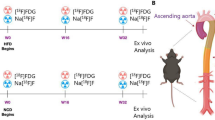Abstract
The purpose of this study was to determine whether the hepatic uptake of dialysed technetium-99m labelled low-density lipoprotein (99mTc-LDL) reflects the hepatic LDL receptor activity and to what extent the non-LDL receptor-dependent 99mTc-LDL uptake by non-parenchymal cells relates to the diagnostic utility of quantitative 99mTc-LDL scintigraphy of the liver. New Zealand White rabbits and Watanabe Heritable Hyperlipidaemic rabbits, which were sacrificed 24 h after simultaneous injection of 99mTc-LDL and iodine-125 labelled LDL, were clearly discriminated by their hepatic 99mTc-LDL uptake according to their genetically different hepatic LDL receptor activity. Yet the hepatic 99mTc-LDL uptake exceeded the 125I-LDL uptake in all animals. The different hepatic uptake of the tracers was elucidated in the isolated perfused rat liver and was due to rapid intracellular degradation and the release of low molecular catabolites of 125I-LDL. In contrast, 99mTc activity was trapped in the liver. Analysis of biliary 99mTc activity provided evidence for the excretion of 99mTc-labelled apolipoprotein B. The amount of biliary excreted protein-bound 99mTc was linked to total hepatic 99mTc-LDL uptake and presumably reflected LDL receptor-mediated apolipoprotein excretion. Collagenase liver perfusion in Sprague-Dawley rats 90 min following simultaneous injection of 99mTc- and 125I-LDL and subsequent cell separation by gradient centrifugation revealed that 99mTc-LDL and 125I-LDL had a comparably low uptake into non-parenchymal cells; thus its contribution can be neglected for scintigraphic purposes. Planar scintigraphy was performed in New Zealand White and Watanabe Heritable Hyperlipidaemic rabbits. The different hepatic LDL receptor activities of the two groups were reflected by the slope of the liver/heart ratios over 24 h post injection and correlated well with their respective cumulative hepatic 99mTc-LDL uptake. Thus, we have been able to show that 99mTc-LDL scintigraphy using dialysed 99mTc-LDL can quantitate different genetically determined hepatic LDL receptor activities. The finding of the biliary excretion of 99mTc-labelled apolipoprotein B deserves further attention for its possible diagnostic utility.
Similar content being viewed by others
References
Leitha T, Hermann M, Hüttinger M, Angelberger P, Dudczak R. Technetium-99m labelled LDL as a tracer for quantitative LDL scintigraphy. I. Tracer purification, in vitro and in vivo long-term stability, validation and biodistribution. Eur J Nucl Med 1993;20:667–673.
Goldstein JL, Ho YK, Basu SK, Brown MS. Binding site on macrophages that mediates uptake and degradation of acetylated low density lipoprotein producing massive cholesterol ester deposition. Proc Natl Acad Sci USA 1979; 76:333–337.
Meddings JB, Dietschy JM. Regulation of plasma levels of low-density lipoprotein cholesterol: interpretation of data on low-density lipoprotein turnover in man. Circulation 1986;74:805–814.
Goldstein JL, Basu SK, Brown MS. Receptor mediated endocytosis of LDL in cultured cells. Methods Enzymol 1983;98:241–260.
Lees RS, Garabedian HD, Lees AM, Schumacher J, Miller A, Isaacsohn JL, Derksen A, Strauss HW. Technetium-99m low density lipoproteins: preparation and biodistribution. J Nucl Med 1985;26:1056–1062.
Bilheimer DW, Watanabe Y, Kita T. Impaired receptor-mediated catabolism of low density lipoprotein in the WHHL rabbit, an animal model of familial hypercholesterolemia. Proc Natl Acad Sci USA 1982;79:3305–3309.
Dunn WA, Wall DA, Hubbard AL. Use of isolated, perfused liver in studies of receptor-mediated endocytosis. Methods Enzymol 1983;98:225–241
Gores GJ, Kost LJ, LaRusso NF. The isolated perfused rat liver: conceptual and practical considerations. Hepatology 1986;6:511–517.
Munthe-Kaas AC, Seglen PO. The use of metrizamide as a gradient medium for isopycnic separation of rat liver cells. FEBS Lett 1974;43:252–256.
Garvey JS, Heil MF. Separation and collection of rat liver macrophages. Methods Enzymol 1984;108:286–294.
Berry MN, Friend DS. High-yield preparation of isolated rat liver parenchymal cells. J Cell Biol 1969;43:506–520.
Lipid and lipoprotein analysis: manual of laboratory operation, vol I. Publication No. (NIH) 75-628, US Department of Health, Education and Welfare, Washington, D.C., 1974.
Bilheimer DW, Stone NJ, Grundy SM. Metabolic studies in familial hypercholesterolemia. Evidence for a gene-dosage effect in vivo. J Clin Invest 1979;64:524–532.
Vallabhajosula S, Goldsmith S. 99mTc-low density lipoprotein: intracellularly trapped radiotracer for noninvasive imaging of low density lipoprotein metabolism in vivo. Semin Nucl Med 1990;XX:68–79.
Lees AM, Lees RS. 99mTechnetium-labeled low density lipoprotein: receptor recognition and intracellular sequestration of radiolabel. J Lipid Res 1991;32:1–8.
Renaud G, Hamilton RL, Havel RJ. Hepatic metabolism of colloidal gold-low-density lipoprotein complexes in the rat: evidence for bulk excretion of lysosomal contents into bile. Hepatology 1988;9:380–392.
Barnwell SG, Godfrey PP, Lowe PJ, Coleman R. Biliary protein output by isolated perfused rat livers. Biochem J 1983;210:549–557.
Kawamoto T, Mao SJT, LaRusso NF. Biliary excretion of apolipoprotein B by the isolated perfused rat liver, relationship to receptor-mediated uptake of human low density lipoprotein and biliary lipid secretion. Gastroenterology 1987;92:1236–1242.
McNamara DJ, Kolb R, Parker TS, Batwin H, Samuel P, Brown CD, Ahrens EH Jr. Heterogeneity of cholesterol homeostasis in man. J Clin Invest 1987;79:1729–1739.
Lin DS, Connor WE. The long term effects of dietary cholesterol upon plasma lipids, lipoproteins, cholesterol absorption and sterol balance in man: the demonstration of feedback inhibition of cholesterol biosynthesis and increased bile acid excretion. J Lipid Res 1980;21:1042–1052.
Maranhao RC, Quintao ECR. Long term steroid metabolism balance studies during cholesterol-free and cholesterol-rich diets: comparison between normal and hypercholesterolemic individuals. J Lipid Res 1983;49:1135–1152.
Author information
Authors and Affiliations
Rights and permissions
About this article
Cite this article
Leitha, T., Staudenherz, A., Gmeiner, B. et al. Technetium-99m labelled LDL as a tracer for quantitative LDL scintigraphy. Eur J Nucl Med 20, 674–679 (1993). https://doi.org/10.1007/BF00181757
Received:
Revised:
Issue Date:
DOI: https://doi.org/10.1007/BF00181757




